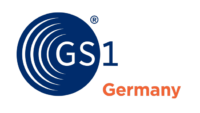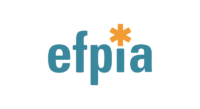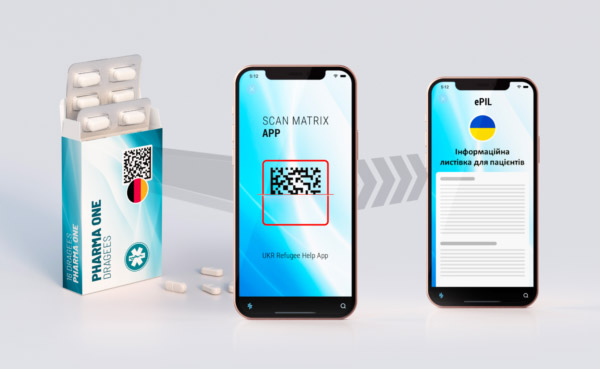Target
App-based, language-specific patient instructions for Ukrainian refugees using existing pharma 2D codes to help refugees overcome language barriers when accessing usage instruction information.
Challenges
- Handling of multiple brands and multiple products
- Urgency/ high pressure for time-to-market
- Different information (experience) for patients and doctors
- Compliant with already printed
Data Matrix codes and NTINs - Easy to use and to plug-in
Solutions
- Language specific resolving service using existing DataMatrix code
- Specific Information for doctors
- Multi-tenant environment
12 global pharma companies enrolled - Integration via API with existing J&J scan app
- Bulk data import for existing IDs & e-leaflet redirect URL
ID Level
- Product-Level (NTIN / PPN)
Core Modules used
- Digital Link Resolver including Content Types
- Context Engine
- Sub-Tenant-Management
- Import/ Export for product data
- Analytics
References / Partners


+ 16 Global Pharma Companies
Further Informations
Digital Patient Information
How Smart Product Services Overcome Language Barriers
Providing patients with accurate information can be vital in critical situations. It becomes even more challenging when people are forced to leave their home country and suddenly find themselves with medication instructions in a foreign language. This is exactly where a pioneering joint project comes in: With the help of GS1 Digital Link technology, the GoodsTag Smart Products Platform, and the EFPIA initiative, life-saving package leaflets are made easily accessible for Ukrainian refugees — directly on their smartphones and in their own language.
The goal: Clear information for millions of refugees
Since the start of the war in Ukraine, millions of people have been forced to ensure their medical treatment in a foreign country. Many face one key issue: the printed package inserts for medicines are usually only available in the language of the target market — increasing the risk of misunderstandings during use.
The solution: With the “Scan Matrix” service, patients can simply scan the existing GS1 DataMatrix code on the packaging and immediately receive the electronic package leaflet (ePIL) in their own language — quickly, free of charge, and reliably.
How it works: Existing codes, new possibilities
What makes this special: There is no need for new labels. Instead, the service makes use of the 2D codes that already exist in the pharmaceutical sector. Smart redirection is handled via the GS1 Resolver, which is based on the flexible Smart Products Platform from GoodsTag.
This allows pharmaceutical companies to:
- Provide multilingual package leaflets
- Deliver different, context-specific content for patients and healthcare professionals
- Keep existing production and packaging processes unchanged
Challenges that have been solved
This initiative demonstrates how digital services can work under significant time pressure. Several hurdles had to be overcome in a very short time:
- Multiple brands & products with different active ingredients
- Urgent market launch while maintaining full regulatory compliance
- Compatibility with packaging already in circulation
- Seamless integration with existing apps and systems
Thanks to the modular setup of GoodsTag’s platform — from the Digital Link Resolver to the Context Engine — all of this was implemented in record time.
Who is involved — and why it works
More than 16 global pharmaceutical companies already provide hundreds of electronic package leaflets (ePILs) for refugees, including Bayer, Boehringer Ingelheim, Janssen Pharmaceutica, Merck, Novo Nordisk Ukraine, Pfizer and Roche Polska.
EFPIA (European Federation of Pharmaceutical Industries and Associations), GS1 Germany, and GoodsTag combine their expertise for this project. The goal: not only to support patients in this crisis but also to show how smart packaging and context-sensitive digital information can be standardised for the future.
GoodsTag: Technology that connects
The foundation of this solution is the GS1 Digital Link Standard, which makes it possible for a single code on the packaging to deliver different content — depending on the language, user group and context. Using the GoodsTag Smart Products Platform, companies can:
- Manage all IDs and content centrally
- Handle multi-tenant environments securely
- Automatically adapt content to the smartphone’s language
- Keep all data flows securely synchronised
What is being used today to help refugees sets the proof of concept for a future in which digital product information becomes the standard: always up to date, multilingual, and user-specific.
A model for the future: Smart pharmaceutical packaging
Practice shows: Such digital solutions turn static packaging information into flexible services. Pharmaceutical companies can:
- Update relevant information at any time
- Deliver context-specific content for patients and professionals
- Dynamically manage languages and content
- Improve compliance and patient safety
For the industry, one thing is clear: Language barriers must not become an obstacle in patient care — and with the Digital Link Standard, the technical possibilities are ready and waiting.

